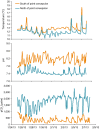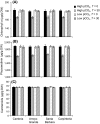Physiological plasticity and local adaptation to elevated p CO2 in calcareous algae: an ontogenetic and geographic approach
- PMID: 27695514
- PMCID: PMC5039319
- DOI: 10.1111/eva.12411
Physiological plasticity and local adaptation to elevated p CO2 in calcareous algae: an ontogenetic and geographic approach
Abstract
To project how ocean acidification will impact biological communities in the future, it is critical to understand the potential for local adaptation and the physiological plasticity of marine organisms throughout their entire life cycle, as some stages may be more vulnerable than others. Coralline algae are ecosystem engineers that play significant functional roles in oceans worldwide and are considered vulnerable to ocean acidification. Using different stages of coralline algae, we tested the hypothesis that populations living in environments with higher environmental variability and exposed to higher levels of pCO 2 would be less affected by high pCO 2 than populations from a more stable environment experiencing lower levels of pCO 2. Our results show that spores are less sensitive to elevated pCO 2 than adults. Spore growth and mortality were not affected by pCO 2 level; however, elevated pCO 2 negatively impacted the physiology and growth rates of adults, with stronger effects in populations that experienced both lower levels of pCO 2 and lower variability in carbonate chemistry, suggesting local adaptation. Differences in physiological plasticity and the potential for adaptation could have important implications for the ecological and evolutionary responses of coralline algae to future environmental changes.
Keywords: California; life‐history stages; local adaptation; ocean acidification; photosynthesis; physiological plasticity; spore; upwelling.
Figures





Similar articles
-
Major loss of coralline algal diversity in response to ocean acidification.Glob Chang Biol. 2021 Oct;27(19):4785-4798. doi: 10.1111/gcb.15757. Epub 2021 Jul 16. Glob Chang Biol. 2021. PMID: 34268846
-
Coralline algal structure is more sensitive to rate, rather than the magnitude, of ocean acidification.Glob Chang Biol. 2013 Dec;19(12):3621-8. doi: 10.1111/gcb.12351. Epub 2013 Oct 8. Glob Chang Biol. 2013. PMID: 23943376 Free PMC article.
-
Rhodoliths holobionts in a changing ocean: host-microbes interactions mediate coralline algae resilience under ocean acidification.BMC Genomics. 2018 Sep 24;19(1):701. doi: 10.1186/s12864-018-5064-4. BMC Genomics. 2018. PMID: 30249182 Free PMC article.
-
Coralline algae (Rhodophyta) in a changing world: integrating ecological, physiological, and geochemical responses to global change.J Phycol. 2015 Feb;51(1):6-24. doi: 10.1111/jpy.12262. Epub 2015 Jan 23. J Phycol. 2015. PMID: 26986255 Free PMC article. Review.
-
Global change ecotoxicology: Identification of early life history bottlenecks in marine invertebrates, variable species responses and variable experimental approaches.Mar Environ Res. 2012 May;76:3-15. doi: 10.1016/j.marenvres.2011.10.004. Epub 2011 Nov 15. Mar Environ Res. 2012. PMID: 22154473 Review.
Cited by
-
Effects of ocean acidification on growth and photophysiology of two tropical reef macroalgae.PLoS One. 2023 Nov 17;18(11):e0286661. doi: 10.1371/journal.pone.0286661. eCollection 2023. PLoS One. 2023. PMID: 37976304 Free PMC article.
-
Calcifying algae maintain settlement cues to larval abalone following algal exposure to extreme ocean acidification.Sci Rep. 2017 Jul 18;7(1):5774. doi: 10.1038/s41598-017-05502-x. Sci Rep. 2017. PMID: 28720836 Free PMC article.
-
Population-specific vulnerability to ocean change in a multistressor environment.Sci Adv. 2023 Jan 20;9(3):eade2365. doi: 10.1126/sciadv.ade2365. Epub 2023 Jan 20. Sci Adv. 2023. PMID: 36662849 Free PMC article.
-
Geographical gradients in selection can reveal genetic constraints for evolutionary responses to ocean acidification.Biol Lett. 2017 Feb;13(2):20160784. doi: 10.1098/rsbl.2016.0784. Biol Lett. 2017. PMID: 28148831 Free PMC article. Review.
-
Effect of environmental history on the habitat-forming kelp Macrocystis pyrifera responses to ocean acidification and warming: a physiological and molecular approach.Sci Rep. 2021 Jan 28;11(1):2510. doi: 10.1038/s41598-021-82094-7. Sci Rep. 2021. PMID: 33510300 Free PMC article.
References
-
- Abramoff, M. D. , Magalhaes, P. J. , & Ram, S. J. (2004). Image processing with ImageJ. Biophotonics International, 11(7), 36–42.
-
- Adey, W. H. (1998). Review‐coral reefs: Algal structured and mediated ecosystems in shallow, turbulent, alkaline waters. Journal of Phycology, 34, 393–406.
-
- Angilletta, M. J. , Niewiarowski, P. H. , & Navas, C. A. (2002). The evolution of thermal physiology in ectotherms. Journal of Thermal Biology, 27, 249–268.
LinkOut - more resources
Full Text Sources
Other Literature Sources

